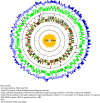From array-based hybridization of Helicobacter pylori isolates to the complete genome sequence of an isolate associated with MALT lymphoma
- PMID: 20537153
- PMCID: PMC3091627
- DOI: 10.1186/1471-2164-11-368
From array-based hybridization of Helicobacter pylori isolates to the complete genome sequence of an isolate associated with MALT lymphoma
Abstract
Background: Helicobacter pylori infection is associated with several gastro-duodenal inflammatory diseases of various levels of severity. To determine whether certain combinations of genetic markers can be used to predict the clinical source of the infection, we analyzed well documented and geographically homogenous clinical isolates using a comparative genomics approach.
Results: A set of 254 H. pylori genes was used to perform array-based comparative genomic hybridization among 120 French H. pylori strains associated with chronic gastritis (n = 33), duodenal ulcers (n = 27), intestinal metaplasia (n = 17) or gastric extra-nodal marginal zone B-cell MALT lymphoma (n = 43). Hierarchical cluster analyses of the DNA hybridization values allowed us to identify a homogeneous subpopulation of strains that clustered exclusively with cagPAI minus MALT lymphoma isolates. The genome sequence of B38, a representative of this MALT lymphoma strain-cluster, was completed, fully annotated, and compared with the six previously released H. pylori genomes (i.e. J99, 26695, HPAG1, P12, G27 and Shi470). B38 has the smallest H. pylori genome described thus far (1,576,758 base pairs containing 1,528 CDSs); it contains the vacAs2m2 allele and lacks the genes encoding the major virulence factors (absence of cagPAI, babB, babC, sabB, and homB). Comparative genomics led to the identification of very few sequences that are unique to the B38 strain (9 intact CDSs and 7 pseudogenes). Pair-wise genomic synteny comparisons between B38 and the 6 H. pylori sequenced genomes revealed an almost complete co-linearity, never seen before between the genomes of strain Shi470 (a Peruvian isolate) and B38.
Conclusion: These isolates are deprived of the main H. pylori virulence factors characterized previously, but are nonetheless associated with gastric neoplasia.
Figures




Similar articles
-
Identification of a genetic marker of Helicobacter pylori strains involved in gastric extranodal marginal zone B cell lymphoma of the MALT-type.Gut. 2004 Jul;53(7):931-7. doi: 10.1136/gut.2003.028811. Gut. 2004. PMID: 15194637 Free PMC article.
-
Molecular relationships of Helicobacter pylori strains in a family with gastroduodenal disease.Am J Gastroenterol. 1999 Feb;94(2):364-8. doi: 10.1111/j.1572-0241.1999.859_u.x. Am J Gastroenterol. 1999. PMID: 10022630
-
The functional status of the Helicobacter pylori sabB adhesin gene as a putative marker for disease outcome.Helicobacter. 2004 Apr;9(2):158-64. doi: 10.1111/j.1083-4389.2004.00213.x. Helicobacter. 2004. PMID: 15068418
-
[Causal relationship between Helicobacter pylori infection and upper gastroduodenal diseases].Nihon Rinsho. 2001 Feb;59(2):239-45. Nihon Rinsho. 2001. PMID: 11218392 Review. Japanese.
-
[Helicobacter pylori infection and gastric diseases--pathogenesis and effects of eradication].Gan To Kagaku Ryoho. 2002 Aug;29(8):1341-9. Gan To Kagaku Ryoho. 2002. PMID: 12214459 Review. Japanese.
Cited by
-
Inflammatory cytokine and microRNA responses of primary human dendritic cells cultured with Helicobacter pylori strains.Front Microbiol. 2013 Aug 20;4:236. doi: 10.3389/fmicb.2013.00236. eCollection 2013. Front Microbiol. 2013. PMID: 23970881 Free PMC article.
-
Comparative analysis of the full genome of Helicobacter pylori isolate Sahul64 identifies genes of high divergence.J Bacteriol. 2014 Mar;196(5):1073-83. doi: 10.1128/JB.01021-13. Epub 2013 Dec 27. J Bacteriol. 2014. PMID: 24375107 Free PMC article.
-
A Systematic In-silico Analysis of Helicobacter pylori Pathogenic Islands for Identification of Novel Drug Target Candidates.Curr Genomics. 2017 Oct;18(5):450-465. doi: 10.2174/1389202918666170705160615. Curr Genomics. 2017. PMID: 29081700 Free PMC article.
-
Horizontal gene transfers with or without cell fusions in all categories of the living matter.Adv Exp Med Biol. 2011;714:5-89. doi: 10.1007/978-94-007-0782-5_2. Adv Exp Med Biol. 2011. PMID: 21506007 Free PMC article. Review.
-
A comprehensive analysis of Helicobacter pylori plasticity zones reveals that they are integrating conjugative elements with intermediate integration specificity.BMC Genomics. 2014 Apr 27;15:310. doi: 10.1186/1471-2164-15-310. BMC Genomics. 2014. PMID: 24767410 Free PMC article.
References
Publication types
MeSH terms
Substances
LinkOut - more resources
Full Text Sources
Molecular Biology Databases

